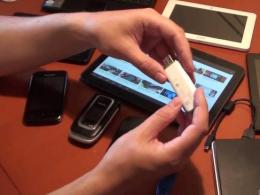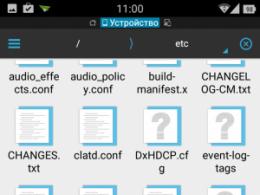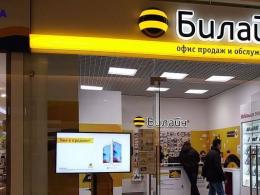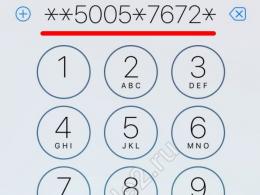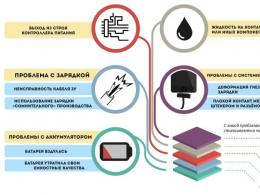How information is stored on a flash drive. Step-by-step instructions for using a flash drive
A flash drive is a storage device that uses flash memory. Flash memory is non-volatile. It can be electrically erased and reprogrammed.
Thus, it is a type of electrically erasable programmable read-only memory called EEPROM (Electrically Erasable Programmable Read-Only Memory) - electrically erasable programmable ROM. This type of memory can be erased and filled with data up to a million times. Flash drives are similar to conventional hard drives and can replace them. Flash memory is used for easy and fast storage and transfer of information.
About flash memory
Flash drives are often used in products that run at low power and those that may need to operate in harsh environments. Flash memory is non-volatile, and therefore flash drives do not need to be backed up by a battery. Flash memory is solid state. This means that there is nothing mechanical in it. Everything is purely electronic. Flash memory has a grid of columns and rows, each cell has two transistors at each intersection point in the grid. A thin oxide layer separates the transistors in each pair. One transistor in the pair is called the floating gate and the other is known as the control gate. The floating gate can hold an electrical charge. This charge lies in the electrical insulation of the oxide layer separating it from the control gate. Thus, any electrons placed on the floating gate remain on it. This makes flash memory non-volatile. The job of flash memory is precisely to add and remove electrons from floating gates.
How does a flash drive work?
It must be inserted into USB port on the computer. Today's operating systems can detect flash drives and install necessary drivers on one's own. Once a device is discovered, it can be used to store data. The flash drive can be removed from the computer only after its work is completed. The system will tell you when it is safe to delete it, after which it can be physically deleted.
The flash drive consists of a printed circuit board and is covered in a plastic or rubber casing that makes it durable. The USB connector that sticks out is closed with a removable cover. Most flash drives use USB connection Type A, this makes them compatible with standard computer connectors. Hence, they can be connected directly to a port on your computer.
Flash drives do not require any additional device drivers. When a flash drive is connected to a computer running a block logical unit operating system, this abstraction from the implementation details of complex flash storage devices is achieved and the operating system can use any file system or addressing system blocks. In short, the Operating System treats it as HDD. When plugged in, the flash drive goes into emulation mode, which means it emulates hard work disk later. This makes transferring data between a flash drive and a computer much easier.
Flash drives are used in the management of operating systems in order to turn personal computers to the electrical network. In such cases, they contain operating system and is used to boot the system. Flash drives have an advantage over other devices due to their low power consumption and low failure rate. In addition, flash drives have a small portable size. They enable fast data transfer with less hassle. Basically, they are Plug-and-Play devices. They do not require any special training on your part to be able to use them. They have a large memory store, more memory than floppy disks or CDs.
During the early years of their evolution, flash drives couldn't handle too many erase cycles. This made early flash drives unsuitable for data that needed frequent updates. To fill this gap, manufacturers have developed an alignment method that physically distributes data across all memory locations. Modern flash drives can withstand up to a million cycles.
USB flash drives
USB flash drive is a trendy word today in computer technology. This is a flash memory or NAND type storage device. The main components of a flash drive include a USB Type A connector, a storage controller, a NAND flash chip, and a crystal oscillator. The USB connector acts as an interface between the device and the computer. The storage controller consists of a tiny RISC processor. It also has some memory on the chip (it can be ROM and RAM). The flash memory chip does the actual work of storing data. The crystal oscillator generates clock signals and controls data output from the device. The LEDs, which act as indicators, provide write protection and toggle some other components that may be part of flash drives.
Using a flash drive
- Connect your flash drive to your computer.
- The computer will indicate to you that it has detected an external device.
- The operating system will treat it like any other hard drive. No special device drivers are needed. No specific file system is required.
- Go to the "My Computer" menu and you will see the flash drive among other drives.
- You will be able to open it like any other hard drive.
Advantages of flash drives
- They are lightweight and portable.
- They are reliable. They are scratch resistant and not affected by magnetic fields.
- Flash memory is non-volatile.
- They are plug-and-play devices, so they are easy to use.
- The computer treats them like any other hard drive, making data transfer easy.
Disadvantages of Flash Drives
- They are small in size. So it can be easily lost.
- Frequent use causes wear and tear, especially at the point where they connect to the computer.
- There is a limit to the number of write and erase cycles they can handle.
- Using a flash drive on different computers makes it susceptible to infections. A virus on a disk can destroy data or make it unreadable.
Modern flash drives are equipped with security measures such as encryption or even biometrics. They are equipped with a protective cover, which makes them reliable. Although the number of erase and write cycles may be limited. They have the added benefit of being capable of capacity, speed, portability, and low power consumption. It is clear that the downsides of flash drives are negligible compared to the ease of use they offer. Flash drives are one of the most popular devices data storage. They can download software, store important documents, projects, and homework, and store music, movies, and pictures.
We are accustomed to enjoy the benefits of civilization and recently we do not even notice them. But many are wondering how this or that mechanism works. This article is written for curious people who are wondering how a flash drive works? You can restore flash drives.
Memory cells are used to store information. One cell can only store one bit. The binary code element 0 or 1 is written to this bit.
In one flash drive there are billions of cells that are ready to remember information for you. Eight bits make one byte. So a one gigabyte drive consists of 8,589,934,592 memory cells, and this article fits in approximately 20,000 cells.
More about memory cells
Memory cells are transistors. The transistor has two n-type semiconductors, they are on its sides. These semiconductors have many free electrons. When these particles move, current flows.
In the middle of n-type semiconductors is a p-type semiconductor, which is characterized by a lack of electrons. Through it, current is transferred through holes in which there are not enough electrons.
Due to the different conductance patterns of these semi-conductive materials, current cannot pass between them.
The transistor design provides for a control gate, which is located above the p-semiconductor. It is an electrode and voltage is applied to it. When a positive voltage is applied, it pushes the holes of the p-semiconductor away and attracts particles. This is justified by the attraction of opposite charges.
This results in the so-called n-junction. It is needed to transfer electricity from one n-semiconductor to another, as a result of which the transistor passes current.
The control gate has a p-semiconductor separation called a floating gate (polycrystalline silicon wafer). With a negative plate charge, the current will not be conducted by the transistor, regardless of the control gate charge, which may interfere with its operation in the future.
Reading data

The process of reading information from a flash drive is as follows. The control valve is energized. This is necessary to determine the zero or one that is in this memory cell. The combination of zeros and ones gives an idea to the machine that reads the information about the encoded characters.
With an excess of electrons on the control gate, no current flows. This indicates a unit.
When there is a shortage of electrons on the control gate, current flows. This indicates zero.
Data recording

To record information, it is necessary to fill the floating gate with electrons. But this is a difficult task due to the dielectric layer that surrounds it and does not allow current to pass.
Electrons are placed in a floating cell by applying a positive charge, higher than what is supplied during reading, at which they jump, passing through the dielectric layer.
When information is erased, a negative voltage is applied to the floating gate, and the electrons fall off the floating gate.
That's how that little thing works, which makes it easier for us to share information.
I offer to download as a gift free book: causes of freezes on the PC, data recovery, computer network through electrical wiring and many others interesting chips.
Even more interesting news, and most importantly communication, solutions to your problems! Join telegram -
We will talk about the principle of operation of flash drives. The topic is becoming increasingly relevant: "flash drives"are in your pocketeveryone, in mobile phones and tablets inner memory works on the same principle, and even ultraportable laptops of the latest generations refuse to use the usual hard drives in favor of SSDs. They run faster, consume less power (which is very important for laptops), they are quiet, cool and shock resistant. How does it work?
To begin with, flash memory is a non-volatile and rewritable memory based on special properties semiconductors. The first term in her description refers to the simple fact that she does not need access to electricity to store information. In order for such drives to store information, they do not need power supply, and for reading the flash drive does not need any moving systems. In the HDD, this is a disk rotating at high speed, a spindle and a head. This is very good: a flash drive is not so easy to damage, it usually has a long service life, it quickly exchanges data with a computer. These drives are light, simple, and will soon be cheap. So far, they are more expensive than hard drives and are bad because if the number of reads from an SSD is not limited, then the number of rewrite cycles is still not infinite. As a rule, the same memory cells can be overwritten up to ten thousand times.
Each flash memory cell does not contain capacitors - conductors that take up a lot of space and have a complex structure. This is just one transistor of a special architecture that can store electrons, i.e. information.
In addition, flash memory cells are highly scalable: they can be made incredibly small, which means that a lot of data is written to a small medium. With the current level of computerization and development of technology, transistors can be made extremely small. This means only one thing: flash memory takes up extremely little space. Soon we will be able to fit terabytes of information on a regular flash drive.
A typical memory map is a field of columns and columns, in the intersection area of \u200b\u200bwhich there are always two transistors. They are separated by a special insulating layer.

As you probably know, all digital information stored in megabytes. One megabyte is 1024 kilobytes. There are 1024 bytes in one kilobyte. One byte is 8 bits.
Our computers only understand the binary (binary system). That is, one bit of information is either zero or one.
Bit(English) bi nary digi t; also play on words: engl. bit - a little) (one binary digit in binary system calculus) is one of the most famous units of measurement of information.
A bit occupies one location in flash memory. The main thing in this mechanism is an electron. When you turn on a flash drive in a computer, electricity runs through it, running into all the cells. Each cell is made up of source And channel. Current flows from the source to the channel only if controller with the help of the same electricity, it will charge the electron, and, as if on a bridge, the current will run further along the electron.

If electricity has run, then the cell is zero, if it has not run, then it is one. The value of a cell, that is, a bit, depends on whether there is an electron there or not. When we write information to a flash drive, millions of controllers charge and discharge millions of electrons.
All the described processes take place on the memory chip. But a typical flash drive consists of more than just it. It also has a USB male connector. Another device in a flash drive is a controller that provides mutual understanding between the drive and the computer - for this it has a small processor and a tiny amount random access memory. The latter is such a "buffer" for transferring information.

Imagine that you and your friends are unloading a carload of sugar. The wagon itself is a memory chip. The processor is the senior in the group who manages the process. And RAM on a flash drive is such a place, a kind of sump, where the bags are dumped directly next to the car - before another loader transfers them to the warehouse (computer).
On the flash drive there is also an oscillator - a controller that sets the frequency of the system. This, one might say, is your employer, whose task is to ensure, on the one hand, top speed unloading the car and safety for the health of workers - on the other hand. The LED activity indicator is needed directly for users: so that they know whether the drive is active or not. There is also a switch on flash drives that puts the media in write-protect mode. That, in fact, is all.
Today, flash drives are the most popular external storage media. Unlike optical and magnetic disks (CD / DVD and hard drives, respectively), flash drives are more compact and resistant to mechanical damage. And due to what compactness and stability were achieved? Let's find out!
The first thing to note is that there are no moving mechanical parts inside the flash drive that can be damaged by drops or shocks. This is achieved due to the design - without a protective case, a flash drive is printed circuit board to which the USB connector is soldered. Let's look at its components.
Main Components
The components of most flash drives can be divided into basic and additional.

The main ones include:
- NAND memory chips;
- controller;
- quartz resonator.
- USB connector
NAND memory
The drive works thanks to NAND-memory: semiconductor microcircuits. The chips of such memory, firstly, are very compact, and secondly, they are very capacious: if at first flash drives lost in volume to optical discs familiar at that time, now even Blu-Ray discs exceed in capacity. Such memory, among other things, is also non-volatile, that is, it does not require a power source to store information, unlike RAM chips created using a similar technology. 
However, NAND memory has one disadvantage compared to other types of storage devices. The fact is that the service life of these chips is limited by a certain number of rewriting cycles (steps of reading / writing information in cells). On average, the number of read-write cycles is 30,000 (depending on the type of memory chip). It seems like an incredible amount, but it actually equates to about 5 years of heavy use. However, even if the limit is reached, the flash drive can continue to be used, but only for reading data. Also, due to its nature, NAND memory is very vulnerable to electrical surges and electrostatic discharges, so keep it away from sources of such hazards.
Controller
Number 2 in the figure at the beginning of the article is a tiny microcircuit - a controller, a communication tool between flash memory and connected devices (PCs, TVs, car radios, etc.). 
A controller (otherwise called a microcontroller) is a miniature primitive computer with its own processor and some amount of RAM used for data caching and service purposes. The procedure for updating the firmware or BIOS means just updating the microcontroller software. As practice shows, the most frequent breakdown flash drives - failure of the controller.
Quartz resonator
This component is a tiny quartz crystal, which, like in an electronic watch, produces harmonic vibrations of a certain frequency. In flash drives, the resonator is used to communicate between the controller, NAND memory, and additional components. 
This part of the flash drive is also at risk of damage, and, unlike problems with the microcontroller, it is almost impossible to solve them on your own. Fortunately, in modern drives, resonators fail relatively rarely.
USB connector
In the vast majority of cases, modern flash drives have a USB 2.0 type A connector, which is focused on receiving and transmitting. The newest drives use USB 3.0 Type A and Type C.
Additional components
In addition to the main components of a flash storage device mentioned above, manufacturers often supply them with optional elements, such as an LED indicator, a write protection switch, and some specific features for certain models.
Led indicator
Many flash drives have a small but fairly bright LED. It is designed to visually display the activity of a flash drive (writing or reading information) or is simply a design element. 
This indicator most often does not carry any functional load for the flash drive itself, and is needed, in fact, only for user convenience or for beauty.
Write protect switch
This element is more typical for SD cards, although it is sometimes found on USB storage devices. The latter are often used in corporate environment as carriers of various information, including important and confidential. To avoid incidents with accidental deletion of such data, manufacturers of flash drives in some models use a protection switch: a resistor that, when connected to the power supply circuit of a storage device, does not electric current get to the memory cells. 
When you try to write or delete information from a drive that has protection enabled, the OS will display the following message.

In a similar way, protection is implemented in the so-called USB keys: flash drives that contain security certificates necessary for the correct operation of some specific software.
This element can also break, resulting in an unfortunate situation - the device seems to be operational, but it is impossible to use it. We have material on our site that can help solve this problem.
Unique Components
These include, for example, the presence of Lightning, microUSB or Type-C connectors: flash drives with these are designed for use, including on smartphones and tablets.
Flash memory (eng. Flash-Memory) - a kind of solid-state semiconductor non-volatile rewritable memory.
Operating principle
Flash memory programming
Erase flash memory
History
Characteristics
File systems
Application
Types of memory cards
operator101 operator101

1
normal
Flash memory (eng. Flash-Memory) - a kind of solid-state semiconductor non-volatile rewritable memory.
It can be read any number of times, but such memory can be written to only a limited number of times (maximum - about a million cycles). Flash memory is common and can withstand about 100,000 write cycles - far more than a floppy disk or CD-RW can handle.
Contains no moving parts, so unlike hard drives, more reliable and compact.
Due to its compactness, low cost and low power consumption, flash memory is widely used in portable devices operating on batteries and accumulators - digital cameras and camcorders, digital voice recorders, MP3 players, PDAs, mobile phones, as well as smartphones and communicators. In addition, it is used to store the built-in software in various devices (routers, PBX, printers, scanners), various controllers.
Also, in recent years, there has been a widespread USB flash key fobs (“flash drive”, USB drive, USB disk), which practically replaced floppy disks and CDs.
At the end of 2008, the main disadvantage that prevents devices based on flash memory from being forced out of the market hard drives, is a high price / volume ratio, exceeding this parameter for hard drives by 2-3 times. In this regard, the volume of flash drives is not so large. Although work in these areas is underway. The technological process becomes cheaper, competition intensifies. Many firms have already announced the release SSD drives 256 GB or more.
Another drawback of devices based on flash memory compared to hard drives is, oddly enough, lower speed. Despite the fact that SSD manufacturers claim that the speed of these devices is higher than the speed of hard drives, in reality it turns out to be significantly lower. Of course, an SSD drive does not spend time like a hard drive on overclocking, positioning heads, etc. But the reading time, and even more so writing, of flash memory cells used in modern SSD drives is longer. which leads to a significant reduction overall performance. To be fair, it should be noted that latest models SSD drives and in this parameter are already very close to hard drives. However, these models are still too expensive.
In February 2009, shipments of USB- flash drive with a capacity of 512Gb. This model already appeared on sale in Moscow. The estimated cost of such a model for the end user is planned within $250, which makes such a flash drive a clear competitor. external HDD. The flash drive has a small compact size, USB 2.0 interface, read speed 11MB/sec. and 10MB/sec. for the record. Contents [remove]
Operating principle
Flash memory programming
Erase flash memory
Flash memory stores information in an array of floating gate transistors called cells. In traditional single-level cell (SLC) devices, each cell can store only one bit. Some new multi-level cell (MLC) devices can store more than one bit using different levels electric charge on the floating gate of the transistor.
This type of flash memory is based on the OR element (eng. NOR), because in a floating gate transistor, a low gate voltage indicates one.
The transistor has two gates: control and floating. The latter is completely isolated and is able to hold electrons for up to 10 years. The cell also has a drain and a source. When programming with voltage, an electric field is created on the control gate and a tunnel effect occurs. Some electrons tunnel through the insulator layer and enter the floating gate, where they will remain. The charge on the floating gate changes the "width" of the drain-source channel and its conductivity, which is used when reading.
Programming and reading cells are very different in power consumption: flash memory devices consume quite a lot of current when writing, while when reading, power consumption is low.
To erase information, a high negative voltage is applied to the control gate, and the electrons from the floating gate pass (tunnel) to the source.
In the NOR architecture, each transistor must be connected to an individual contact, which increases the size of the circuit. This problem is solved using the NAND architecture.
The NAND type is based on the NAND element (eng. NAND). The principle of operation is the same, it differs from the NOR type only in the placement of cells and their contacts. As a result, it is no longer necessary to connect an individual contact to each cell, so the size and cost of a NAND chip can be significantly reduced. Also, writing and erasing is faster. However, this architecture does not allow accessing an arbitrary cell.
NAND and NOR architectures now exist in parallel and do not compete with each other, since they are used in different areas of data storage.
History
Flash memory was invented by Fujio Masuoka while he was at Toshiba in 1984. The name "flash" was also coined at Toshiba by Fuji's colleague, Shoji Ariizumi, because the process of erasing the contents of memory reminded him of a flash. Masuoka presented his design at the IEEE 1984 International Electron Devices Meeting (IEDM) held in San Francisco, California. Intel saw great potential in the invention and in 1988 released the first commercial NOR-type flash chip.
The NAND type of flash memory was announced by Toshiba in 1989 at the International Solid-State Circuits Conference. It had a faster write speed and a smaller chip area.
At the end of 2008, the leaders in the production of flash memory are Samsung (31% of the market) and Toshiba (19% of the market, including joint factories with Sandisk). (Data according to iSupply as of Q4"2008). NAND flash memory chips are standardized by the Open NAND Flash Interface Working Group (ONFI). The current standard is the ONFI specification version 1.0, released on December 28, 2006. The ONFI group is supported by competitors Samsung and Toshiba in production of NAND chips: Intel, Hynix and Micron Technology.
Characteristics
The speed of some devices with flash memory can reach up to 100 Mb / s. In general, flash cards have a wide spread of speeds and are usually marked at the speeds of a standard CD drive (150 Kb / s). So the specified speed in 100x means 100 x 150 Kbps = 15,000 Kbps = 14.65 Mbps.
Basically, the volume of a flash memory chip is measured from kilobytes to several gigabytes.
In 2005, Toshiba and SanDisk introduced 1Gb NAND chips based on layered cell technology, where a single transistor can store multiple bits using different levels of electrical charge on the floating gate.
Samsung in September 2006 introduced an 8 GB chip made using 40 nm technological process. At the end of 2007 years of samsung announced the creation of the world's first MLC (multi-level cell) NAND flash memory chip, made using a 30-nm process technology. The capacity of the chip is also 8 GB. The memory chips are expected to enter mass production in 2009.
To increase the volume in devices, an array of several chips is often used. Mainly mid 2007 USB devices and memory cards have a capacity of 512 MB to 64 GB. The largest volume of USB devices is 1 TB.
File systems
The main weak point of flash memory is the number of rewrite cycles. The situation worsens also due to the fact that the OS often writes data to the same place. For example, the file system table is frequently updated, so that the first sectors of memory will use up their supply much earlier. Load balancing allows you to significantly extend the life of the memory.
To solve this problem, special file systems were created: JFFS2 and YAFFS for GNU/Linux and exFAT for Microsoft Windows.
USB flash drives and memory cards such as SecureDigital and CompactFlash have a built-in controller that detects and corrects errors and tries to evenly use the flash memory overwrite resource. On such devices, it makes no sense to use a special file system and, for better compatibility, regular FAT is used.
Application
Flash cards different types(match shown for sizing purposes)
Flash memory is best known for its use in USB flash drives. usb flash drive). The NAND type of memory is mainly used, which is connected via USB via the USB mass storage device (USB MSC) interface. This interface is supported by all operating systems of modern versions.
Due to their high speed, volume and compact size, USB flash drives completely replaced floppy disks from the market. For example, since 2003 Dell has stopped producing computers with a floppy drive.
IN this moment A wide range of USB flash drives is available in various shapes and colors. There are flash drives on the market with automatic encryption of the data written to them. The Japanese company Solid Alliance even produces flash drives in the form of food.
There are special GNU/Linux distributions and versions of programs that can run directly from USB sticks, for example, to use their applications in Internet cafes.
ReadyBoost Technology Windows Vista can use a USB flash drive or a special flash memory built into the computer to increase performance. Memory cards such as SecureDigital (SD) and Memory Stick are also based on flash memory, which are actively used in portable equipment (cameras, mobile phones). Together with USB drives, flash memory occupies a large part of the portable storage media market.
NOR type of memory is more often used in BIOS and ROM memory of devices such as DSL modems, routers, etc. Flash memory allows you to easily update the firmware of devices, while the write speed and volume are not so important for such devices.
Now the possibility of replacing hard drives with flash memory is being actively considered. As a result, the computer turns on faster, and the absence of moving parts will increase the service life. For example, in the XO-1, a “$100 laptop” that is being actively developed for third world countries, instead of hard drive 1 GB flash memory will be used. Distribution is limited by a high price per GB and a shorter shelf life than hard drives due to the limited number of write cycles.
Types of memory cards
There are several types of memory cards used in cell phones.
MMC (MultiMedia Card): MMC format card has a small size - 24x32x1.4 mm. Developed jointly by SanDisk and Siemens. The MMC contains a memory controller and is highly compatible with the devices of the various types. In most cases, MMC cards are supported by devices with an SD slot.
RS-MMC (Reduced Size MultiMedia Card): A memory card that is half the size of a standard MMC. Its dimensions are 24x18x1.4 mm, and its weight is about 6 g, all other characteristics do not differ from MMC. An adapter is required to ensure compatibility with the MMC standard when using RS-MMC cards.
DV-RS-MMC (Dual Voltage Reduced Size MultiMedia Card): DV-RS-MMC memory cards with dual power (1.8 and 3.3 V) feature reduced power consumption, which will allow your mobile phone to work a little longer. The dimensions of the card are the same as those of RS-MMC, 24x18x1.4 mm.
MMCmicro: miniature memory card for mobile devices with dimensions 14x12x1.1 mm. An adapter must be used to ensure compatibility with the standard MMC slot.
SD Card (Secure Digital Card): Supported by SanDisk, Panasonic and Toshiba. The SD standard is a further development of the MMC standard. In terms of size and characteristics, SD cards are very similar to MMC, only slightly thicker (32x24x2.1 mm). The main difference from MMC is copyright protection technology: the card has crypto protection against unauthorized copying, increased protection of information from accidental erasure or destruction, and a mechanical write protection switch. Despite the related standards, SD cards cannot be used in devices with an MMC slot.
SD (Trans-Flash) and SDHC (High Capacity): Old SD cards, so-called. Trans-Flash and the new SDHC (High Capacity) and their readers differ in the maximum storage capacity limit, 2GB for Trans-Flash and 32GB for High Capacity (High Capacity). SDHC readers are backward compatible with SDTF, that is, an SDTF card will be read without problems in an SDHC reader, but only 2GB of the SDHC capacity of a larger capacity will be seen in the SDTF device, or it will not be read at all. It is assumed that the TransFlash format will be completely superseded by the SDHC format. Both sub-formats can be presented in any of the three physical formats. sizes (Standard, mini and micro).
miniSD (Mini Secure Digital Card): From standard cards Secure Digital are smaller in size 21.5x20x1.4 mm. An adapter is used to ensure the operation of the card in devices equipped with a conventional SD slot.
microSD (Micro Secure Digital Card): are on currently(2008) the most compact removable flash memory devices (11x15x1 mm). They are used primarily in mobile phones, communicators, etc., because, due to their compactness, they can significantly expand the memory of the device without increasing its size. The write protection switch is placed on the microSD-SD adapter.
MS Duo (Memory Stick Duo): this standard memory was developed and maintained by Sony. The body is strong enough. At the moment, this is the most expensive memory of all presented. The Memory Stick Duo was developed on the basis of the widely used Memory Stick standard from the same Sony, it is distinguished by its small size (20x31x1.6 mm.).

